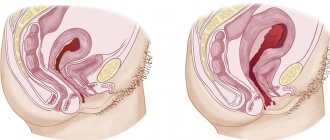When does real milk appear?
Lactation in women begins with the formation of colostrum - a secretion of the mammary glands, which has a unique composition. The time at which colostrum begins to form is individual for each woman; more often it begins to be released in the last months of pregnancy or immediately after childbirth; There are cases when colostrum appears only on the 3rd or 4th day.
Therefore, do not be surprised or worry - on the 1st day after birth, the breasts are soft and as if empty. The amount of colostrum released also varies: from a couple of drops to 100 ml per day.
However, even a few drops of colostrum, which the baby receives every time he latches onto the breast, is priceless for him, as it is very nutritious. Colostrum is rich in protein, minerals, vitamins, hormones, and enzymes. This food is perfectly absorbed by the child's body, since the nutrients have a structure similar to the structure of the tissues of a newborn. Colostrum contains immune factors that protect the baby from viruses and bacteria. In addition, colostrum has laxative properties, it stimulates digestion and helps clear the baby’s intestines of original feces (meconium).
Colostrum gradually changes in composition, turning into transitional milk by the fourth or fifth day. From about the 6th day of lactation, the secretion of the mammary gland is nothing more than mature milk. The process of replacing colostrum with mature milk occurs in women with varying intensity. For some it is faster, for others this process is longer. It is known that in primiparous women the process of converting colostrum into mature milk takes longer, in multiparous women it takes less. The individual characteristics of each woman matter.
Milk production rate
Once milk begins to be produced, it will be impossible to stop this process. The rate of production depends on the size of the mammary glands and their fullness. If the baby sucks the entire breast in one feeding, then milk will be produced very quickly. It is worth knowing that the rate of fluid production of each breast may differ. If milk is produced in large quantities, then the rate of its appearance slows down a little, because it will have nowhere to be stored. But on average, 140 ml of milk is produced per hour.
There are different phases of production, directly depending on when a woman’s milk appeared:
- Autocrine. The mammary glands fill immediately after they are empty if the baby actively takes the breast.
- Endocrine. Milk production depends on the woman’s hormones and usually begins in the first days after the baby is born.
Size does not affect the rate of milk production or the day it comes. Bust size affects the amount of fluid. In some women, the mammary gland cannot accommodate more than 80 ml in the breast, when half a liter of milk can be placed in the other.
Women with large breasts should pump more often
A woman with both small and large breasts can improve the process of breastfeeding. Petite ladies take longer to develop nutrition, so put your baby to the breast more often. Women with large busts should feed their newborn on a schedule, as the baby requires fresh milk. And size 4-5 breasts contain nutrition that is enough for several feedings.
Is it necessary to increase lactation and how to do it?
A significant increase in milk volume is called milk let-down, or breast fullness. In some women, this phenomenon occurs on the 3rd–4th day after birth; in others it is observed later, on the 6th–9th day, that is, after discharge from the maternity hospital.
And the composition of one woman’s milk is different from another woman’s milk. Moreover, your milk is the most harmonious for your child.
To stimulate the formation and release of colostrum and milk, several conditions are necessary.
Restoration of lactation after surgery
There is nothing difficult about establishing lactation after a caesarean section. The following rules must be followed:
- Place your baby on the breast as quickly as possible after surgery. You should not be afraid of the harm of drugs and anesthesia that entered the bloodstream during the CS.
- When milk comes in after a caesarean section, you need to feed the baby at least once every 1.5 hours. What if he is sleeping? Definitely - to wake up. Don't be lazy to do this.
- If your newborn is not breastfeeding well, do not forget to express milk. In this way, you will not only avoid lactostasis, but also increase the amount of liquid received.
- Remember the need and benefits of proper nutrition. The diet should contain fruits and vegetables that are allowed to the mother during breastfeeding.
- Stay hydrated.
Advice! It is very important to learn how to properly apply the baby to the mother’s breast. It should capture the nipple as much as possible, without affecting the areola. If this is the first time a mother has encountered this process, it is better to consult a specialist.
How often should you breastfeed?
An important factor in ensuring full lactation is the free feeding regime, in which the baby himself sets the intervals between feedings. Free feeding or, in other words, feeding at the request of the child, means putting the child to the breast as many times and at such times as he requires, including night hours. A newborn baby may require from 8–10 to 20 or more breastfeedings per day. The duration of one feeding is 20–30 minutes in the first days due to the small amount of milk. After the milk flow has occurred, 15–20 minutes are enough for feeding, since a longer stay of the baby at the breast can contribute to the appearance of cracks in the nipples.
You should feed in a position that is comfortable for you and your baby, in a calm environment. It is advisable that when feeding, the baby has the opportunity to have as close contact with you as possible “skin to skin”, “eye to eye”. Such close contact contributes to the formation of optimal lactation and the establishment of close psycho-emotional contact between you and the child, which is very important for its full development.
What to do if the milk doesn't come?
Some women have to deal with the phenomenon when milk does not come in at the right time after childbirth. Then the mother begins to worry and asks what to do to get milk. This often happens because the breasts are not developed. The milk flow is not visible, so it appears to be absent. To improve lactation, you can use the following methods:
- massage the breasts;
- include in your diet foods that enhance lactation;
- take special medications to increase lactation.
The most preferable option would be to put the baby to the breast frequently. Even when it seems that the baby is sucking “in vain,” there is no need to despair, you should continue to apply.
Prolactin, a hormone produced in the body of a new mother, is responsible for normal lactation. Its production can be enhanced by frequently putting the newborn to the breast, especially at night, since it is at this time that active production of this hormone is observed. Therefore, you should feed your baby at night, and as a result, milk will definitely come.
How to understand that formula is not suitable for your child
Do I need to pump?
Milk let-down is also easier to manage while in a shared ward, as unrestricted breastfeeding can be provided. Given the possibility of unlimited attachment of the baby to the breast, it is better to do without expressing milk at all.
In this case, the amount of milk produced by the mother naturally adapts to the needs of the baby. Of course, in some cases you still have to strain the breast once or twice. Your midwife or lactation consultant will tell you when and how to do this.
In conclusion, it should be said that when feeding a baby on demand, there is no need to use pacifiers. It has been proven that supplementary feeding and additional drinking lead to disruption of the natural balance in the child’s digestive system, to a decrease in milk production, and the likelihood of the baby refusing to breastfeed also increases. Therefore, in modern maternity hospitals, breastfed children are not prescribed supplemental feeding with artificial formulas and additional drinks without special medical indications.
“Time in the maternity hospital,” from the book “Woman’s Health During Pregnancy”
On what day does milk come in after childbirth?
The birth of a child is the most wonderful event in the life of every woman, which they look forward to and prepare for. But along with this, the new mother faces many questions that make her worry. The most pressing of them are questions about feeding the baby: when the milk comes in, what to do if there is no milk, how to feed the baby then. Let's try to answer each of them.
The first days after childbirth
When milk appears, a woman who has given birth feels pain in the mammary glands. But the mother will have to endure them so that the baby not only becomes full, but also receives the necessary nutrients contained in breast milk.
When a baby is just born, there is no milk in the mammary glands yet. If you press on the breast, colostrum is released - a thick yellow liquid. It is very valuable. Despite the fact that only a few droplets are released, it brings great benefits to the baby. Thanks to colostrum, the baby's immune system begins to develop. This product prepares the newborn’s body so that he can fully accept and digest food. Breast milk is very nutritious, which is why the baby quickly becomes full.
In the first days after birth, when the baby is not yet strong enough, a few sips of colostrum are enough for him. Many new mothers worry about this, believing that the breasts are empty and there is no milk there. To some extent, this is true, there is still very little nutritious product, but this is enough for the baby that has just been born. When the baby adapts and gets used to new conditions, he will need more food so that he can get enough. This is where the question arises: when does milk come in after childbirth?
how to teach a baby to use a bottle
The appearance of breast milk - how it happens and what affects it
Several factors should be noted that influence the process of milk appearing in the mammary glands:
- Method of delivery - natural birth or cesarean section.
- Full term pregnancy or not.
- This is the first time a woman gives birth or already has children.
On the third day after the baby is born, milk begins to appear. At the moment it still has a yellowish color, but is less thick in consistency than colostrum. If there is a lot of milk, it can be expressed. Three days after birth, a sharp flow of milk is usually observed. The breasts become larger and firmer, and in some cases, with a large amount of breast milk, changes occur in the shape of the nipples. Sometimes there is an increase in temperature.
If the pregnancy is premature and the woman gave birth ahead of schedule, or stimulation was used, the new mother’s body takes much longer to recover. For this reason, milk may be delayed for several days.
How long it takes for breast milk to come in depends largely on the medications used during the caesarean section. In this situation, milk appears after five days.
When does a first-time mother begin to produce milk?
The body of each specific woman has individual characteristics. Therefore, it is extremely difficult to give an exact date for the appearance of milk. According to statistics, women who become mothers for the first time usually receive milk three days after giving birth. This only happens in situations where the baby is full-term and was born through the vaginal birth canal.
It also happens that breast milk in first-born women comes after 5-7 days. After this, you will see an increase in the flow of nutritious food for your baby every day. Its peak usually occurs after the tenth week after birth. It will remain this way until the end of breastfeeding.
When lactation begins, the mammary glands increase in size, the woman feels quite pronounced pain, dilated veins can be seen through the skin, and an increase in body temperature is observed. The woman will feel similar symptoms for two days, then lactation will improve. The volume of breast milk in the first week after birth is 200-300 ml. For women who have become mothers not for the first time, everything happens a little differently.
Why does a newborn hiccup after feeding?
When does milk come in for multiparous women?
No matter how long the baby is born, it is always long-awaited. Immediately after birth, it is applied to the mother's breast. Despite the fact that there is no milk, there is a drink that brings invaluable benefits - colostrum. Even if its amount is small, in the first days this is enough for a newborn. But mom is still worried and waiting for full milk to come. She is afraid that she will not be able to feed her child, and he will not be full. Women who are not mothers for the first time and already have children have milk coming in more quickly compared to first-time mothers. In most cases, already on the third day, the baby can eat fully.
After repeated births, the appearance of breast milk is no longer accompanied by such severe pain, and the feeling of breast fullness is less pronounced. The female body is already prepared for lactation and knows what to do in this case.
However, no matter how many times a child is born, when milk comes in, this process is accompanied by a feeling of heat in the chest. It is for this reason that in the maternity hospital the temperature is measured not in the armpit, but in the bend of the elbow.
What to do if the milk doesn't come?
Some women have to deal with the phenomenon when milk does not come in at the right time after childbirth. Then the mother begins to worry and asks what to do to get milk. This often happens because the breasts are not developed. The milk flow is not visible, so it appears to be absent. To improve lactation, you can use the following methods:
- massage the breasts;
- include in your diet foods that enhance lactation;
- take special medications to increase lactation.
The most preferable option would be to put the baby to the breast frequently. Even when it seems that the baby is sucking “in vain,” there is no need to despair, you should continue to apply.
Prolactin, a hormone produced in the body of a new mother, is responsible for normal lactation. Its production can be enhanced by frequently putting the newborn to the breast, especially at night, since it is at this time that active production of this hormone is observed. Therefore, you should feed your baby at night, and as a result, milk will definitely come.
How to understand that formula is not suitable for your child
How to make milk come faster?
All mothers want to feed their baby as quickly as possible, for this they need the milk to come as early as possible. To speed up the process of receiving a nutritious product, you can use several recommendations.
Previously, it was noted that prolactin is responsible for the flow of milk. Its production in a woman’s body increases when she breastfeeds her newborn. This is a reason to put the baby to the breast more often. Thanks to this, the volume of nutrient fluid will increase.
The opinion that you should not feed a baby at night is wrong. This is not only possible, but also necessary. The production of hormones is activated precisely at night. You should change breasts every feeding. That is, if the last time the mother fed the baby from the right breast, the next time she should give him the left. Thanks to this, there will be uniform development of the mammary glands. On the fourth day after birth, you need to reduce the amount of fluid you drink to prevent severe pain when milk appears.
In conclusion, it should be said that even those mothers who have not received milk even after a week should not despair. It happens that the baby receives the first drops of a nutritious product ten days after birth, and sometimes later.
By adhering to the above recommendations, you can speed up the process of milk supply and prevent problems with lactation in the future.
how to wean your baby off night feeding
Video: first milk after childbirth
howtogetrid.ru
Doctors' opinion
All obstetricians and gynecologists agree: after a CS, a woman can and should breastfeed. Why don't many people succeed in this? The main reason lies in the mother's insufficient knowledge regarding breastfeeding.
What advice can you give:
- Not enough milk? First of all, consult a specialist. It may be enough to develop the breasts to open the ducts.
- Is it possible to supplement the baby? Of course, but you need to do this with a spoon so that he doesn’t get used to the bottle.
- If there is no milk at all, what should I do? In this case, you will need the help of a mammologist and, possibly, a number of additional examinations (ultrasound, tests).
It is important! CS is a difficult operation. A woman’s physical and emotional state does not always return to normal quickly. Even these factors can influence the fact that a woman in labor has little milk. This is why the care and support of loved ones is so important during this period.










